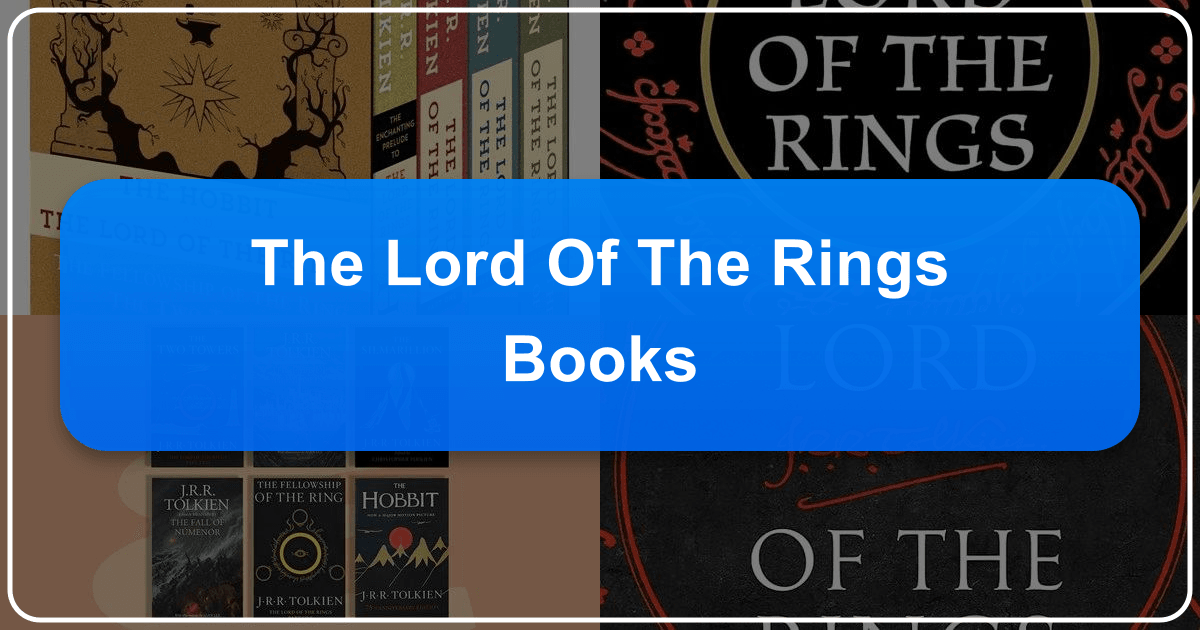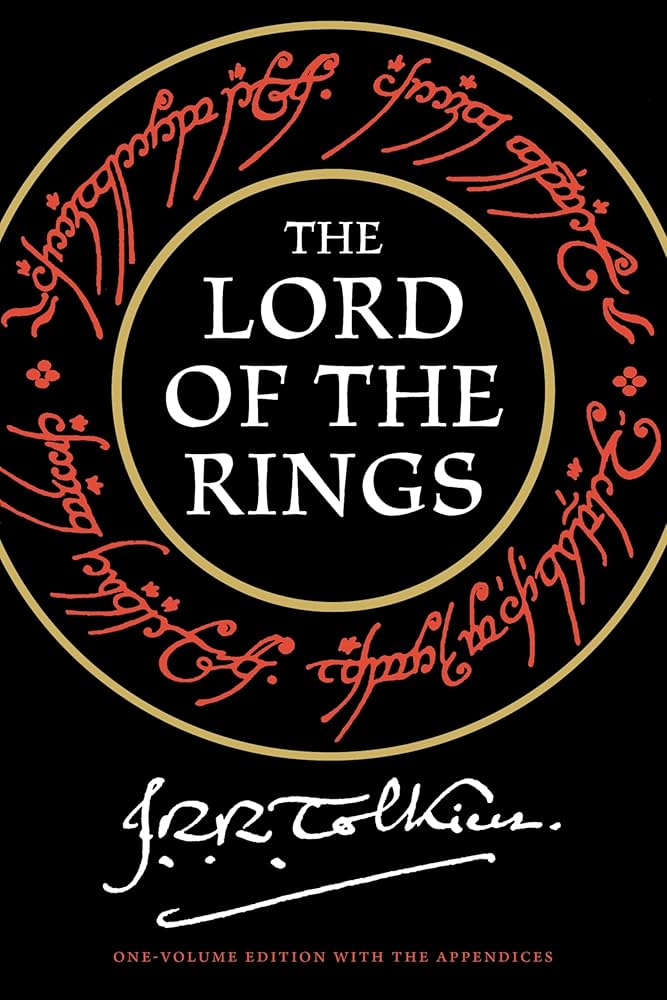The Lord of the Rings Books: A Comprehensive Guide

J.R.R. Tolkien’s The Lord of the Rings is more than just a fantasy epic; it’s a foundational text that has profoundly shaped literature, film, and popular culture. Its enduring appeal lies in its richly detailed world, memorable characters, and exploration of timeless themes such as good versus evil, the corrupting influence of power, and the importance of friendship and sacrifice. This comprehensive guide will delve into the books themselves, explore Tolkien’s life and work, examine the educational and cultural impact of The Lord of the Rings, and discuss the various ways readers and scholars engage with this monumental work.
A Reader’s Journey Through Middle-earth: Exploring the Books
The Lord of the Rings comprises three books: The Fellowship of the Ring, The Two Towers, and The Return of the King. However, fully appreciating Tolkien’s creation often involves exploring a wider body of work, including The Hobbit, which serves as a prequel, and The Silmarillion, a collection of myths and legends that form the foundation of Middle-earth’s history.

The Hobbit: A Whimsical Beginning
Before embarking on the grand adventure of The Lord of the Rings, it’s recommended to start with The Hobbit. This seemingly simpler tale introduces readers to the world of hobbits, the Shire, and the magical ring that would later become the central focus of the trilogy. The Hobbit sets the stage, establishing Tolkien’s writing style and laying the groundwork for the more complex narratives to come. It’s a journey of self-discovery for Bilbo Baggins, a home-loving hobbit thrust into an unexpected adventure with a band of dwarves and a wise wizard, Gandalf. This introduces readers to the core elements of Tolkien’s world and serves as an excellent introduction to the larger legendarium.
The Lord of the Rings: The Epic Quest
The Fellowship of the Ring opens with Frodo Baggins inheriting Bilbo’s ring, revealed to be the One Ring, an artifact of immense power forged by the Dark Lord Sauron. The story follows Frodo and his companions, the Fellowship of the Ring, on their perilous quest to destroy the Ring in the fires of Mount Doom, the only way to defeat Sauron and save Middle-earth.

The Two Towers continues the story as the Fellowship is broken, and its members face their own individual challenges. This book explores different facets of Middle-earth, introducing new characters and locations, and significantly raising the stakes of the conflict.
The Return of the King brings the trilogy to a climactic conclusion. Frodo’s journey to Mordor intensifies, culminating in a desperate battle against Sauron’s forces and Frodo’s ultimate act of self-sacrifice. The appendices provide vital historical context, enriching the understanding of the events within the main narrative and providing a deeper dive into the world’s history, making them essential reading for those interested in fully understanding Tolkien’s vision.
The Silmarillion: Unveiling the Ancient History

The Silmarillion, compiled and edited by Tolkien’s son Christopher, offers a glimpse into the First Age of Middle-earth, a period long before the events of The Hobbit and The Lord of the Rings. It recounts the creation of the world, the rise and fall of powerful beings, and the origins of many of the characters and elements that appear in the more well-known stories. While dense and demanding, The Silmarillion provides crucial background information, adding depth and complexity to the already rich tapestry of Tolkien’s Middle-earth.
Unfinished Tales and Other Works: Further Explorations
Tolkien left behind a vast collection of unpublished writings and notes, which have been meticulously compiled and published by his son, Christopher Tolkien, in Unfinished Tales and The History of Middle-earth. These works offer a treasure trove of additional stories, sketches, and insights into Tolkien’s creative process, providing further context and enriching the understanding of the already extensive legendarium. They offer deeper explorations into the backstories of characters and events, satisfying readers’ thirst for even more Middle-earth lore.
J.R.R. Tolkien: The Author and His Inspirations
J.R.R. Tolkien’s life and experiences significantly shaped his writing. His background as a philologist, his experiences in World War I, and his deep love of mythology and language all contributed to the creation of Middle-earth.
Biographical Context and Writing Style:
Tolkien was a professor of Anglo-Saxon at Oxford University, and his deep understanding of languages and mythology profoundly influenced his work. His meticulous attention to detail, evident in the rich languages and histories he constructed for Middle-earth, reflects his scholarly background. His writing style is characterized by a blend of lyrical prose, detailed descriptions, and a profound sense of history and mythology. This style created a sense of verisimilitude and immersion rarely seen in fantasy writing before him.
Inspirations and Influences:
Tolkien’s work drew inspiration from various sources, including Norse and Germanic mythology, Finnish epic poetry (the Kalevala), and classical literature. He created a complex and coherent mythology that seamlessly integrated language, history, and legend, creating a world that felt both fantastical and believable. This attention to detail and world-building set a new standard for the fantasy genre and has greatly influenced countless works since.
Reading and Learning: Unpacking the Educational and Cultural Value
The Lord of the Rings offers more than just entertainment; it offers rich opportunities for learning and personal growth.
Educational Value and Literary Analysis:
The books can be analyzed through various literary lenses, offering opportunities for discussions of themes, character development, narrative structure, and the use of language. Tolkien’s masterful world-building and complex characters provide ample material for critical analysis, making the books a valuable resource for literary study at various levels.
Life Lessons and Philosophical Themes:
The story is infused with philosophical themes, including the nature of good and evil, the dangers of power, the importance of courage, and the enduring power of hope. These themes provide opportunities for reflection on one’s own values and beliefs, prompting profound personal insights and fostering discussion about various moral and ethical dilemmas. The characters’ journeys offer readers valuable lessons in resilience, perseverance, and the importance of loyalty and friendship.
Libraries and Archives: Preserving the Legacy
The enduring popularity of The Lord of the Rings has ensured its place in libraries and archives worldwide.
Public and Digital Libraries:
The books are readily available in most public and digital libraries, making them accessible to a wide range of readers. The digital availability has greatly expanded access for readers with varying needs and preferences, bringing Tolkien’s work to a much wider audience.
Rare Collections and Archives:
Many rare book collections and archives hold original manuscripts, drafts, and letters from Tolkien, providing valuable insights into his creative process. These collections offer invaluable resources for scholars and researchers, offering a glimpse into the evolution of his iconic stories.
Cultural Impact and Literary Influence
The Lord of the Rings transcends its genre, leaving an undeniable mark on culture and inspiring countless adaptations and creative works.
Literary Influence and Genre Development:
Tolkien’s meticulous world-building and the depth of his mythology have had an immeasurable impact on the fantasy genre and literature as a whole. His creation of detailed languages, histories, and mythologies set a new standard for the genre, paving the way for countless authors to create similarly immersive and richly detailed worlds. His impact can be seen across numerous subgenres of fantasy, from high fantasy to urban fantasy and beyond.
Adaptations and Awards:
The series has inspired numerous adaptations, including the highly acclaimed film trilogy directed by Peter Jackson. These adaptations have further popularized the story and introduced it to new generations of readers and viewers. Tolkien’s work has received numerous awards, solidifying its place as a pivotal work of literature. The awards, both literary and cinematic, reflect the work’s critical acclaim and widespread popular appeal.
Communities and Fandom:
A passionate and dedicated fan community surrounding The Lord of the Rings actively engages with the books, exploring its themes, creating fan fiction, artwork, and other creative endeavors. This vibrant community reflects the deep emotional connection many readers have with the story and its enduring themes. The continued engagement of fans keeps Tolkien’s work alive and relevant, ensuring that the legacy of The Lord of the Rings continues to grow and adapt to the changing times.
This comprehensive guide only scratches the surface of the vast and multifaceted world of The Lord of the Rings. The books themselves, Tolkien’s life, the educational opportunities they present, their place in libraries, and their immense cultural influence make them a truly unique and rewarding subject of study. Whether a long-time fan or a newcomer to Middle-earth, there is always more to discover in Tolkien’s epic creation.